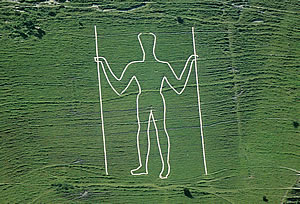Scrapyard Meadows is another amazing part of the park. it is a chalk grassland with labyrinth and all. The team use chalk as a way of reducing fertility and raising the PH balance in the soil.
Apparently the less fertility, the more plant diversity.
I need to be conscious of the materials and techniques that Ken and the team employ in order to work in harmony with the wildlife and plant conservation that happens here. So it got me thinking about chalk.
Chalk, as it turns out, is made up almost entirely of ‘coccoliths’, the shell of a plankton. So over millions of years the skeletons of this plankton built up on sea floor and eventually compressed into the soft, porous rock that we know so well.
Chalk under the microscope show ancient plankton skeletons!
As a material is super soft, carvable, soluble, natural - and has an amazing history! It was used in prehistorical cave drawings, to create ‘magic circles’ in ritual magic, on school blackboards and to lower the PH balance of soils.
Not to mention the epic scaled chalk hill figures, or geoglyphs around Britain.





